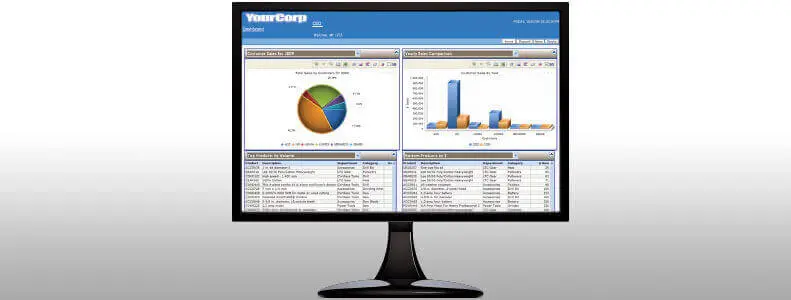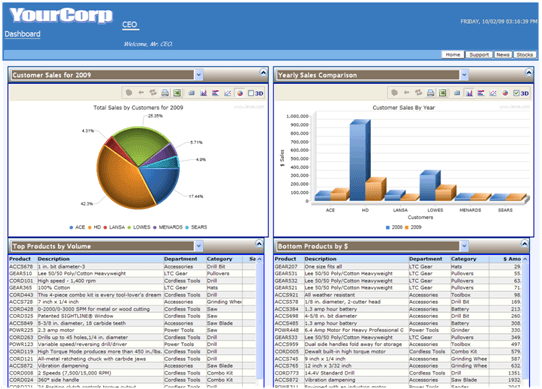If you were asked to describe an executive dashboard, your thoughts might include words like: colorful, graphical, charts, and panels. Generally, these descriptions are correct. However, all of these “flashy” attributes accomplished with the latest technology are not what make a dashboard successful. A dashboard is a tool for presenting business intelligence clearly and concisely so that managers can quickly assess the health of the business and make timely decisions for improvement. 
An executive dashboard can look good, provide accurate information, and still fail. That may be disconcerting to many IT people because these two attributes have historically been good measures of success. After all, what more can they want? We provided them with accurate information and presented it in a nice format. However, with executive dashboards, an additional attribute is required. Since the purpose of the dashboard is monitoring, the critical question becomes, “Does it clearly and quickly deliver valuable information for monitoring (the pulse of the business or area)?” Stated another way, can the person viewing the executive dashboard simply and quickly answer the question: “How is my business doing today?” (or “How is my area doing today?”).
It is probably fair to say that in order to “monitor” something the information required might be somewhat different from many traditional displays and reports. Most often, displays and reports present information about a particular topic. Consider these examples: Orders Taken Today, Sales Month-to-Date, and Expenses Year-to-Date. This information is fairly standard for most businesses, probably required for most businesses, and provides valuable information. However, does the information tell the viewer how that area is doing? Let’s consider each from the perspective of monitoring.
- Orders Taken Today: Provides summary or detailed information about the customer orders taken for the day. If the value of orders taken today is $150,000 is this good?
- Sales Month-to-Date: Provides summary information about the sales from the beginning of the month through the current date. If the sales month-to-date is $325,000 is this good?
- Expenses Year-to-Date: Provides summary information about expenses for the year so far. It may even break the expenses out by category. If expenses are only $65,000 is this good?
What is missing in these examples in order to “monitor” performance? The missing piece of information is the comparison data that provides context. In order to measure performance and determine if you are doing well, average, or poorly, you need the data that answers the question “compared to what?” Let’s look at these again.
- Orders Taken Today: If the average value for daily orders taken for the past 90 days is $280,000, then $150,000 for today may indicate that you are doing poorly.
- Sales Month-to-Date: If the sales target for the month is $200,000, then the current month-to-date figure of $325,000 indicates that you are doing well.
- Expenses Year-to-Date: If the budgeted amount for expenses year-to-date is $50,000, then the current year-to-date figure of $65,000 indicates that you have spent more than budgeted.
Hopefully these examples clearly highlight how monitoring differs from reviewing information. Numbers are not enough. The person viewing the executive dashboard must have the information required to determine whether action should be taken. To put it bluntly, with dashboards, the conclusion should hit you right between the eyes.
An executive dashboard can assist managers by:
- Answering fundamental questions about the business or business unit
- Alerting them to issues or problems as they occur
- Providing information to make decisions that impact the business
Imagine the time saved if the person can scan the big picture, and:
- If no action is required, move on
- If action is required, zoom in on important specifics, link to supporting details if necessary, and make a timely and intelligent business decision
With an executive dashboard that considers and presents from this perspective, you can go to management and say “Mr. CEO, VP, CFO, I can provide a tool that will allow you to (add your company’s value statements here…)”, and you will really be able to deliver on that promise.
There are a large number of pre-built dashboards available for purchase. Perform an internet search on “executive dashboard” or “business intelligence” and you will certainly confirm that. There are also many tools available to build your own. So, how do you decide on which to purchase, or what to build?
In order to determine your dashboard requirements:
- Interview the users/departments to be served
- Gather the Key Performance Indicators to be presented
- Gather the data to be presented and the comparison data (context)
- Gather the types of presentation to be used
- Gather ideas for the future
What are some key questions to ask in order to choose (or build) a dashboard?
- Will it work in my technical environment?
- Will it provide the graphical presentations my company requires?
- Will it provide the other types of presentation my company requires?
- Is it necessary that the dashboard be able to be maintained by non-technical people?
- Is it necessary that the dashboard allow downloading of data?
- Can my technical staff use it to provide the results identified?
This decision should be treated like any well-managed project. Do your best to gather requirements and future desires. Review the available choices. Consider and justify the ROI. Make an intelligent selection. Gather knowledge and put a structure in place to support it.
Let me clarify that dashboards are not just for executives (even though my title begins with “Executive Dashboards”). Dashboards can serve valuable roles in many departments and areas, and for many people. Consider a dashboard on a production or packaging line that displays real time information about units completed vs. units scheduled, or units per hour vs. target units per hour. Good information for monitoring performance can be valuable almost anywhere.
It is obvious that technology is involved in the creation and customization of dashboards. However, take care to not let it become the driving force. The possibilities available through the use of cool technology can take on a life of their own, causing the true business goal to be missed. When building dashboard panels, keep in mind key words like insight, intelligence, context, and monitoring.
Remember, with Executive Dashboards, it’s not technical, it’s about the business.












